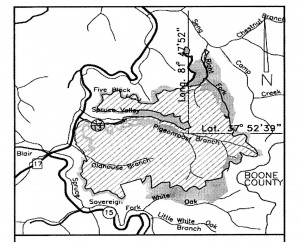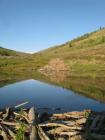The week that was, 10/11-17/2009
Posted on | October 18, 2009 | No Comments

The Spruce Mine, Logan Co., West Virginia. Source: The Charleston Gazette. Click on the map to be taken to the Gazette blog "Coal Tatoo."
The Spruce Mine as currently configured would bury more than seven miles of streams. –– Ken Ward, Jr, Coal Tatoo blog at the Charleston Gazette, October 16, 2009
The U.S. Environmental Protection Agency said Friday it planned to use its authority for the first time to revoke a previously issued permit for a West Virginia surface mine. — NPR / AP, October 16, 2009
Region III is aware that EPA has never before used its Section 404(c) authority to review a previously permitted project since Congress enacted the Clean Water Act in 1972. That it is necessary in this circumstance … reflects the magnitude and scale … of this mountaintop removal mining operation — the largest strip mining operation ever proposed in Appalachia when it was first permitted by the Corps. — October 16, 2009 Letter from William C. Early, Acting Regional Administrator EPA Region III to Colonel Robert D. Peterson, District Engineer, US Army Corps of Engineers, Huntington, West Virginia, posted by Ken Ward, Jr at the Charleston Gazette
“To say that I am mad would be an understatement.” — West Virginia Governor Joe Manchin, NPR / AP, October 16, 2009
Natural gas is vital to the nation’s energy needs and can be an important bridge between dirty coal and renewable alternatives. The process of extracting it, however, is not risk-free. Known as hydraulic fracturing, it involves shooting a mix of water, sand and chemicals — many of them highly toxic — into the ground at very high pressure to break down the rock formations and free the gas. The technique is used in 90 percent of the oil and gas operations in the United States. And while most drilling occurs without incident, “fracking” has been implicated in hundreds of cases of impaired or polluted drinking water supplies in states from Alabama to Wyoming. — New York Times editorial “Shale and our water,” October 16, 2009
Arthur Berman, a Texas-based geological consultant, likened the optimistic projections for production from gas shale fields across the country to banks buying into mortgage securitizations, which spurred the housing market crisis and economic meltdown. — “Analyst: Gas shale may be next bubble to burst,” Denver Post / AP, October 12, 2009
“This whole thing with the Clean Water Act, it’s just a front. They want our land, they want our water, period,” said Carlos Salazar of the Northern New Mexico Stockman’s Association. — “New Mexico ranchers worry about water protection proposal,” Denver Post / AP, October 17, 2009
When Congress passed the Clean Water Act in 1972, lawmakers clearly hoped to clean up polluted rivers and lakes, not promote the travel of boats. — “Re-empower Clean Water Act”, Lebanon Daily News, October 12, 2009

A beaver swims in a lake that it created by building a dam in the northern Utah mountains. Beaver ponds are now seen as ways to combat run-off and increase saturation of snowmelt. Photo: Brett Prettyman, Salt Lake Tribune.
“Dams change everything,” said Mary O’Brien, the Utah Forests program manager for Grand Canyon Trust. “Where water was once just passing through the landscape it is suddenly pausing there, recharging aquifers, creating a riparian area and making a place for all kinds of wildlife to live.” — “Leave it to beavers,” Salt Lake Tribune, October 16, 2009.
Otters are playing in New Mexico waters again after disappearing from the state 60 years ago. Five river otters trapped and transported from Washington state were released Tuesday morning in the Rio Pueblo de Taos on Taos Pueblo land. The first otter out of a holding pen and into the Rio Pueblo “was a very energetic, large male,” said Rachel Conn of the nonprofit Amigos Bravos. “He gave us quite a show. Later we saw he and a female swimming upstream.” Conn said the three male and two female otters seemed comfortable with their new environs. “They were well fed, fattened up with fish. And the weather was very Washingtonesque, drizzling rain.” — “Otters make a return to New Mexico waters,” Santa Fe New Mexican, October 14, 2009
A blue heron swooped by a path littered with foam plastic cups. — “High-speed trains may collide with LA River plans,” Los Angeles Times, October 18, 2009
A colleague of mine notes that he believes not a single library was closed down in the entire State of California during the Great Depression. The dismantling of the University of California system is being done under our noses, one piece at a time, in parallel with the progressive destruction of what used to be the best university and research system in the world. As Joni Mitchell said, “you don’t know what you’ve got till it’s gone.” — Peter Gleick in the San Francisco Chronicle on the proposed closure of the Water Resources Center Archives at UC Berkeley, October 16, 2009
“People blame the horses, but if left on the ranges as they should be they’re not destructive at all.” — Chris Heyde, Animal Welfare Institute, “Wild horse plan rekindles grazing dispute,” San Francisco Chronicle / AP, October 17, 2009
“… if you start grinding them with furniture and things, that scrapes the base. It’s much worse.” — Marine ecologist Paul Brown on tsunami damage to Pacific coral reefs in American Samoa, San Francisco Chronicle / AP, October 17, 2009
We don’t have a water shortage; we have a good management shortage. — Robert Caughlan, co-founder of Friends of the River, San Francisco Chronicle op-ed “Governor, forget the dams,” October 15, 2009

Click here to be taken to the Voice of San Diego story on official excuses about the failure to use water rates as a conservation tool.
Someone at City Hall must really like San Diego’s existing water rate structure. San Diego water officials have offered numerous reasons this year explaining why it isn’t practical to adopt new rates that could boost conservation and penalize waste. — “San Diego’s watery reasoning,” Voice of San Diego, October 15, 2009, via Aquafornia
“There is not a Californian who won’t be affected,” said Tim Quinn, executive director for the Association of California Water Agencies. — “Agencies adopt water diets,” San Diego Union Tribune, October 11, 2009
“If you are trying to develop a 2009 water right, you are about 104 years too late.” — Ken Slattery, water resources manager, Washington State Department of Ecology, “Mitigation: the evergreen state faces a new water reality,” Yakima Herald Republic, October 11, 2009
“If you want to make it more difficult in the valley, then kill all the recycling projects. If you want to make it less likely that water’s going to come to the valley, kill all the recycling projects.” — Rep George Miller (D-CA) on a Republican move to tie approval of water recycling projects in the Bay Area to water shortages in the San Joaquin Valley, “California water war spreads to Congress,” San Francisco Chronicle / AP, October 16, 2009
Cave, Delamar and Dry Lake valleys compose the first phase of the pipeline project. The water the authority plans to tap there could supply more than 37,000 Las Vegas homes. Nearly all of the land in the three basins is managed by the federal government, and almost none of it is inhabited by people … Cave Valley Ranch owns the only sizeable block of private land in the area. The rest of it, [Southern Nevada Water Authority general manager Pat Mulroy] said, “belongs to the coyotes and the rattlesnakes.” — “Ranch to get $4m in settlement,” Las Vegas Review-Journal, October 16, 2009 . Editor’s note: The Great Basin Aquifer underlying the Cave, Delamar and Dry Lake Valley feeds the flow system of the White River and Pahranagat National Wildlife Refuge, preserve for more than 200 species of birds.
Called an “atmospheric river,” the storm pulled a geyser of moisture all the way across the Pacific Ocean, from the tropics near Indonesia. The narrow channel of intense rain scored a direct hit on California’s Central Coast, then gushed like a fire hose all day. — “Storm struck like a hurricane,” Sacramento Bee, October 17, 2009 via Aquafornia
The storm had sustained winds near 135 mph (185 kph) and has a strong chance to grow into a monster Category 5 storm with winds of 155 mph (250 kph), the U.S. National Hurricane Center in Miami reported, though it said the storm was likely to lose much of that punch before hitting land. — “Hurricane Rick called ‘extremely dangerous’ category 4 storm,” Los Angeles Times / AP, October 17, 2009
This post has been updated. A typo in the headline briefly read 11/11 instead of 10/11.
Comments
Leave a Reply




